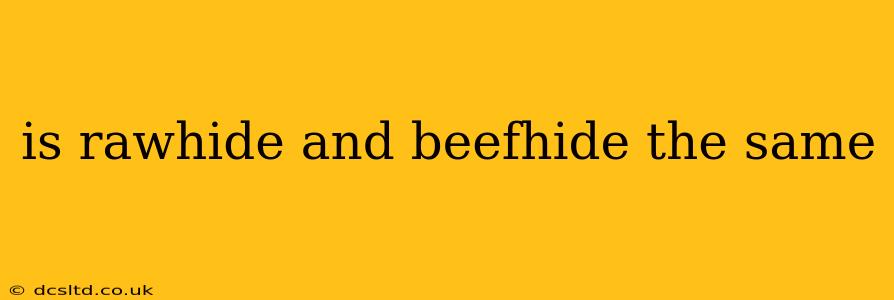While the terms "rawhide" and "beefhide" are often used interchangeably, particularly in the context of dog chews, there are subtle but important distinctions. This article will clarify the differences, addressing common questions and misconceptions surrounding these animal products.
What is Rawhide?
Rawhide, in the context of pet chews, refers to the hide of cattle (beefhide) that has undergone a specific processing method. This process typically involves cleaning, curing (often with salt and preservatives), and sometimes splitting the hide into thinner layers. Importantly, it's not simply air-dried; it's a manufactured product. The degree of processing can vary significantly between manufacturers. Some rawhide chews are minimally processed, while others undergo more extensive treatment, including tanning and coloring.
What is Beefhide?
Beefhide is simply the raw skin of a cow. It's the starting material for many products, including leather, gelatin, and, of course, rawhide chews. In its natural, untreated state, beefhide is not suitable for pet consumption due to potential bacterial contamination and digestive issues. Therefore, any beefhide used for pet chews must undergo processing.
Are Rawhide and Beefhide Chews the Same Thing?
Essentially, yes, all rawhide chews are made from beefhide, but not all beefhide products are rawhide chews. The crucial difference lies in the processing. Beefhide undergoes various treatments to become a rawhide chew.
What are the Different Types of Rawhide Chews?
The manufacturing process significantly impacts the final product. Some common types of rawhide chews include:
- Rolled Rawhide: This is a common type, often made from a single layer of processed beefhide rolled into a rope-like shape.
- Pressed Rawhide: These chews are formed by pressing multiple layers of rawhide together.
- Rawhide Bones: These are often shaped to resemble bones and are typically more durable.
- Rawhide Treats: These include smaller, often flavored pieces of rawhide designed for training or rewarding.
The variations in processing can affect the chew's texture, durability, and digestibility.
Are Rawhide Chews Safe for Dogs?
This is a frequently debated topic. While many dogs enjoy rawhide chews, there are potential risks:
- Choking Hazard: Large or improperly chewed pieces can pose a choking hazard.
- Digestive Issues: Some dogs may experience digestive upset, including constipation or diarrhea.
- Potential for Bacterial Contamination: Although processing helps reduce the risk, contamination is still possible. Always choose rawhide from reputable brands.
- Dental Issues: Hard rawhide can potentially damage teeth.
Always supervise your dog when they are chewing rawhide and choose chews appropriate for their size and chewing strength.
What are the Alternatives to Rawhide Chews?
Numerous safer alternatives exist, including:
- Nylon chews: These are durable and long-lasting.
- Rubber chews: A variety of textures and durabilities are available.
- Natural chews (e.g., bully sticks, antlers): These offer a more natural alternative.
Conclusion
While the terms are closely related, "rawhide" and "beefhide" are not exactly the same. Rawhide chews are a specific processed form of beefhide intended for pet consumption. However, careful consideration of potential risks and safe alternatives is crucial when selecting chews for your dog. Remember to always supervise your pet and choose high-quality products from reputable manufacturers.
